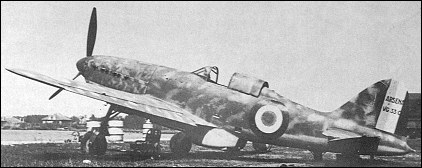|
| The initial derivative of the VG 30, the VG 31, differed
from its predecessor in having the radiator bath moved
aft for CG reasons, and in having a smaller wing of
12.00m2. It was proposed to power this
development with an 860hp Hispano-Suiza 12Y31 12-
cylinder liquid-cooled engine, but the prototype was
never assembled. The VG 32 reverted to the original
wing and was powered by a 1,040hp Allison V-1710-
C15 engine, but the prototype was captured by German
forces at Villacoublay two weeks before its scheduled
maiden flight in 1940. The first development of the
basic design to fly was thus the VG 33, which commenced
its test programme on 24 May 1939. A production
contract for 220 examples was placed in September
1939, this contract eventually being increased to
1,000 machines, but only 19 had been completed by the
Chantiers Aero-Maritimes de la Seine by the time
France collapsed. The VG 33 carried an armament of
one 20mm Hispano-Suiza 404 cannon and four 7.5mm
MAC 1934 M39 machine guns, and was powered by an 860hp Hispano-Suiza 12Y31 engine.

| MODEL | VG.33 |
| WEIGHTS |
| Take-off weight | 2720 kg | 5997 lb |
| Empty weight | 1800 kg | 3968 lb |
| DIMENSIONS |
| Wingspan | 10.80 m | 35 ft 5 in |
| Length | 8.55 m | 28 ft 1 in |
| Height | 3.35 m | 11 ft 0 in |
| Wing area | 14 m2 | 150.69 sq ft |
| PERFORMANCE |
| Max. speed | 558 km/h | 347 mph |
| Cruise speed | 487 km/h | 303 mph |
| Ceiling | 11000 m | 36100 ft |
| Range | 1200 km | 746 miles |
 | A three-view drawing (1663 x 1160) |
| GrahamClayton, e-mail, 29.12.2024 08:25 Three one-off protoypes with the model names VG 34, VG 36 & VG 39 were built, each powered by a Hispano-Suiza engine. reply | | lxbfYeaa, e-mail, 14.03.2024 05:40 20 reply | | Robert Willis, e-mail, 01.09.2020 02:07 re. "It's too bad that they didn't get nearly enough of them into combat to make a difference." - Agreed. The VG-33 was an exquisitely efficient machine. By comparison; the Potez 230, along with the MS 450 & SNCAO 200 were all a complete waste of time & effort. Air Minister La Chambre would have been wise to halt development of these three pointless aircraft by the end of 1938 at the latest. The resources thus freed up would have enabled VG-33 development to be greatly accelerated. This would have guaranteed that Arsenal's fighter could have gone into mass production by the start of Oct '39; enabling French industry to deliver at least two or three hundred prior to the May 10th 1940 attack; engines to be made available by phasing out MS 406 production during this timeframe. reply | | Endicott Road, e-mail, 05.09.2008 05:46 This is the best looking, and probably the best performing French fighter before the surrender. It's too bad that they didn't get nearly enough of them into combat to make a difference. I'm putting together a model of one, and I like the sleek lines.
This also reminds me of the Italian Veltro and Folgore fighters.
ER reply | |
| | pernoloco, e-mail, 23.07.2008 00:18 la verda es que si no sabes el pasado estas por rep�tir lo mismo otra vez la historia no perdona los errores reply |
|
Do you have any comments?
|
| 
COMPANY
PROFILE
All the World's Rotorcraft
|








 pernoloco
pernoloco
20
reply